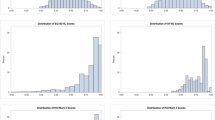Abstract
The EQ-5D index is widely used to assess the preference-based health status. In this paper, we examine the analytical issues of regression models for the US preference-based EQ-5D index score. We propose a two-part approach to model the special features of the EQ-5D index. The first part is a logistic model for the probability of reaching the maximum score 1.0. The second part is a model for the rest of the scores that are less than 1.0, which can be a least squares regression with robust standard errors for the conditional mean, or a quantile regression for conditional quantiles such as the median. We show that the two-part model has some desirable features that are not available in the previously published regression methods for the EQ-5D index. We illustrate the proposed approach with data from the Medical Expenditure Panel Survey. The proposed method may be used for other utility or health related quality of life scores of similar features.



Similar content being viewed by others
References
Austin, P.C.: A comparison of methods for analyzing health-related quality-of-life measures. Value Health 5, 329–337 (2002)
Austin, P.C., Escobar, M., Kopec, J.A.: The use of the tobit model for analyzing measures of health status. Qual. Life Res. 9, 901–910 (2000)
Charlson, M.E., Pompei, P., Ales, K.L., MacKenzie, C.R.: A new method of classifying prognostic comorbidity in longitudinal studies: development and validation. J. Chron. Dis. 40, 373–383 (1987)
Clarke, P., Gray, A., Holman, R.: Estimating utility values for health states of type 2 diabetic patients using the EQ-5D (UKPDS 62). Med. Decis. Making 22, 340–349 (2002)
Deyo, R.A., Cherkin, D.C., Ciol, M.A.: Adapting a clinical comorbidity index for use with ICD-9-CM administrative databases. J. Clin. Epidemiol. 45, 613–619 (1992)
Dolan, P.: Modeling variations for EuroQol health states. Med. Care 35, 1095–1108 (1997)
Dow, W.H., Norton, E.C.: Choosing between and interpreting the Heckit and two-part models for corner solutions. Health Serv. Outcomes Res. Methodol. 4, 5–18 (2003)
Drummond, M.F., Sculphre, M.J., Torrance, G.W., O’Brien, B.J., Stoddart, G.L.: Methods for the Economic Evaluation of Health Care Programmes, 3 edn. Oxford University Press, Oxford (2005)
Duan, N., Manning, W.G., Morris, C.N., Newhouse, J.P.: Choosing between the sample-selection model and the multi-part model. J. Bus. Econ. Stat. 2, 283–289 (1984)
EuroQol Group: EuroQol—a new facility for the measurement of health-related quality of life. Health Policy 16, 199–208 (1990)
EuroQol website: http://www.euroqol.org/web/users/language.php (2007). Accessed 7 May 2007
Fryback, D.G., Dunham, N.C., Palta, M., Hanmer, J., Buechner, J., Cherepanov, D., Herrington, S.A., Hays, R.D., Kaplan, R.M., Ganiats, T.G., Feeny, D., Kind, P.: US norms for six generic health-related quality-of-life indexes from the National Health Measurement study. Med. Care 45, 1162–1170 (2007)
Fu, A.Z., Kattan, M.W.: Racial and ethnic differences in preference-based health status measure. Curr. Med. Res. Opin. 22, 2439–2448 (2006)
Furlong, W.J., Feeny, D.H., Torrance, G.W., Barr, R.D.: The health utilities index system for assessing health-related quality of life in clinical studies. Ann. Med. 33, 375–384 (2001)
Greene, W.H.: Econometric Analysis, 4 edn. Prentice Hall, Upper Sadder River, NJ (2000)
Huang, I.-C., Frangakis, C., Atkinson, M.J., Willke, R.J., Leite, W.L., Vogel, W.B., Wu, A.W.: Addressing ceiling effects in health status measures: a comparison of techniques applied to measures for people with HIV disease. Health Serv. Res. 43, 327–339 (2008)
Huber, P.J.: The behavior of maximum likelihood estimates under nonstandard conditions. Proceedings of the 5th Berkeley Symposium, vol. 1, pp. 221–233 (1967)
Kaplan, R.M., Sieber, W.J., Ganiats, T.G.: The Quality of Well-Being Scale: comparison of the interviewer-administered version with the self-administered questionnaire. Psychol. Health 12, 783–791 (1997)
Koch, C.G., Khandwala, F., Li, L., Estafanous, F.G., Loop, F.D., Blackstone, E.H.: Persistent effect of red cell transfusion on health related quality of life after cardiac surgery. Ann. Thorac. Surg. 82, 13–20 (2006)
Koenker, R.: Quantile Regression. Cambridge University Press, New York, NY (2005)
Leung, S.F., Yu, S.: On the choice between sample selection and two-part models. J. Econom. 72, 197–229 (1996)
MEPS: Weights and response rates for the self-administered questionnaire. In: MEPS HC-079: 2003 Full Year Consolidated Data File, pp. c123–c124. Agency for Healthcare Research and Quality, Rockville, MD (2005)
Olsen, M.K., Schafer, J.L.: A two-part random-effects model for semicontinuous longitudinal data. J. Am. Stat. Assoc. 96, 730–745 (2001)
Schafer, J.L.: Analysis of Incomplete Multivariate Data. Chapman & Hall/CRC, New York. (1997)
Shaw, J.W., Johnson, J.A., Coons, S.J.: US valuation of the EQ-5D health states: development and testing of the D1 valuation model. Med. Care 43, 203–220 (2005)
Sullivan, P.W., Ghushchyan, V.: Mapping the EQ-5D index from the SF-12: US general population preferences in a nationally representative sample. Med. Decis. Making 26, 401–409 (2006)
Sullivan, P.W., Lawrence, W.F., Ghushchyan, V.: A national catalog of preference-based scores for chronic conditions in the United States. Med. Care 43, 736–749 (2005)
Author information
Authors and Affiliations
Corresponding author
Appendix 1: SAS code
Appendix 1: SAS code
The following is the SAS 9.1 program we used to fit the logistic model, LSR, and quantile regression model.

Rights and permissions
About this article
Cite this article
Li, L., Fu, A.Z. Some methodological issues with the analysis of preference-based EQ-5D index score. Health Serv Outcomes Res Method 9, 162–176 (2009). https://doi.org/10.1007/s10742-009-0053-3
Received:
Revised:
Accepted:
Published:
Issue Date:
DOI: https://doi.org/10.1007/s10742-009-0053-3




